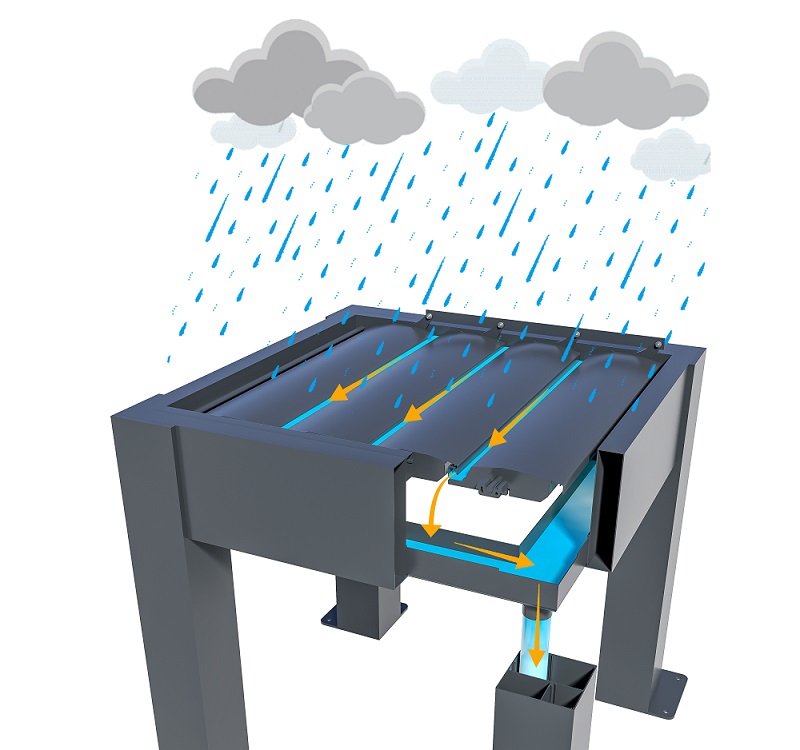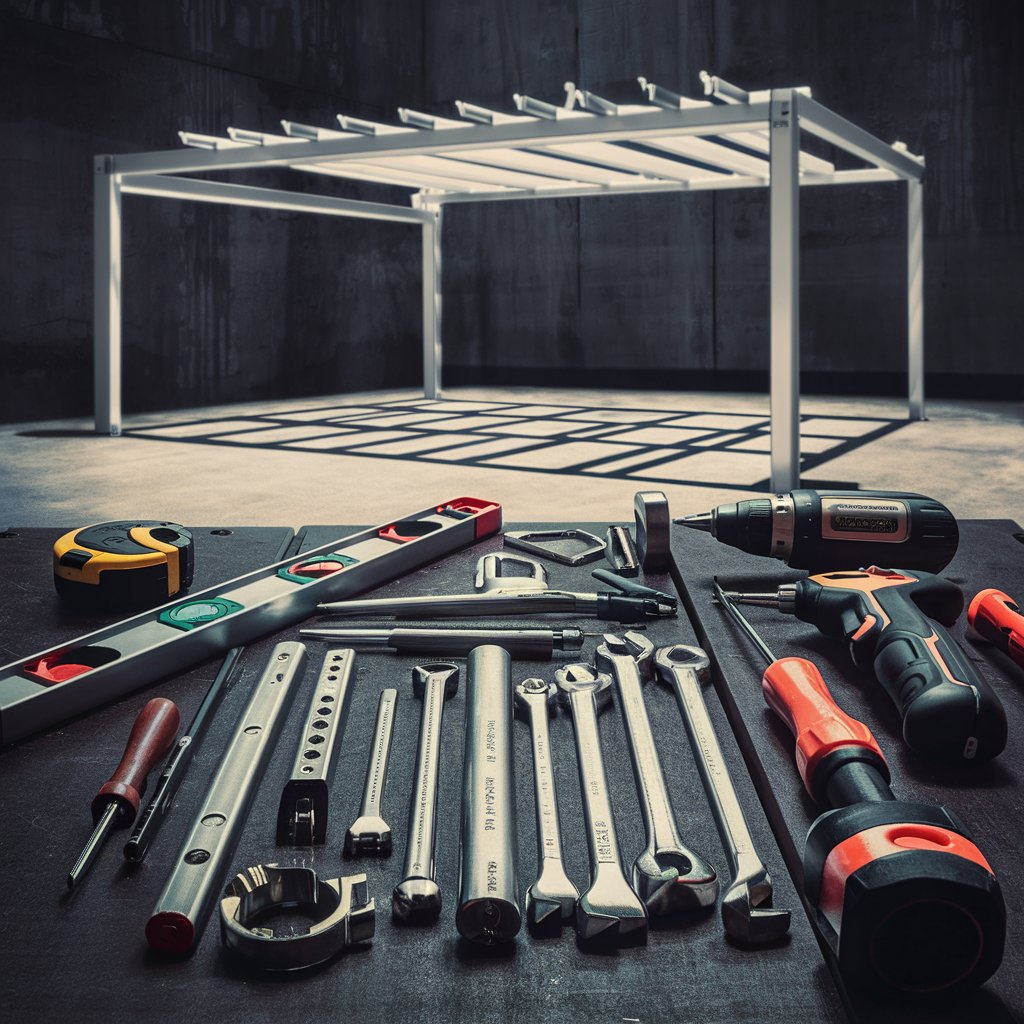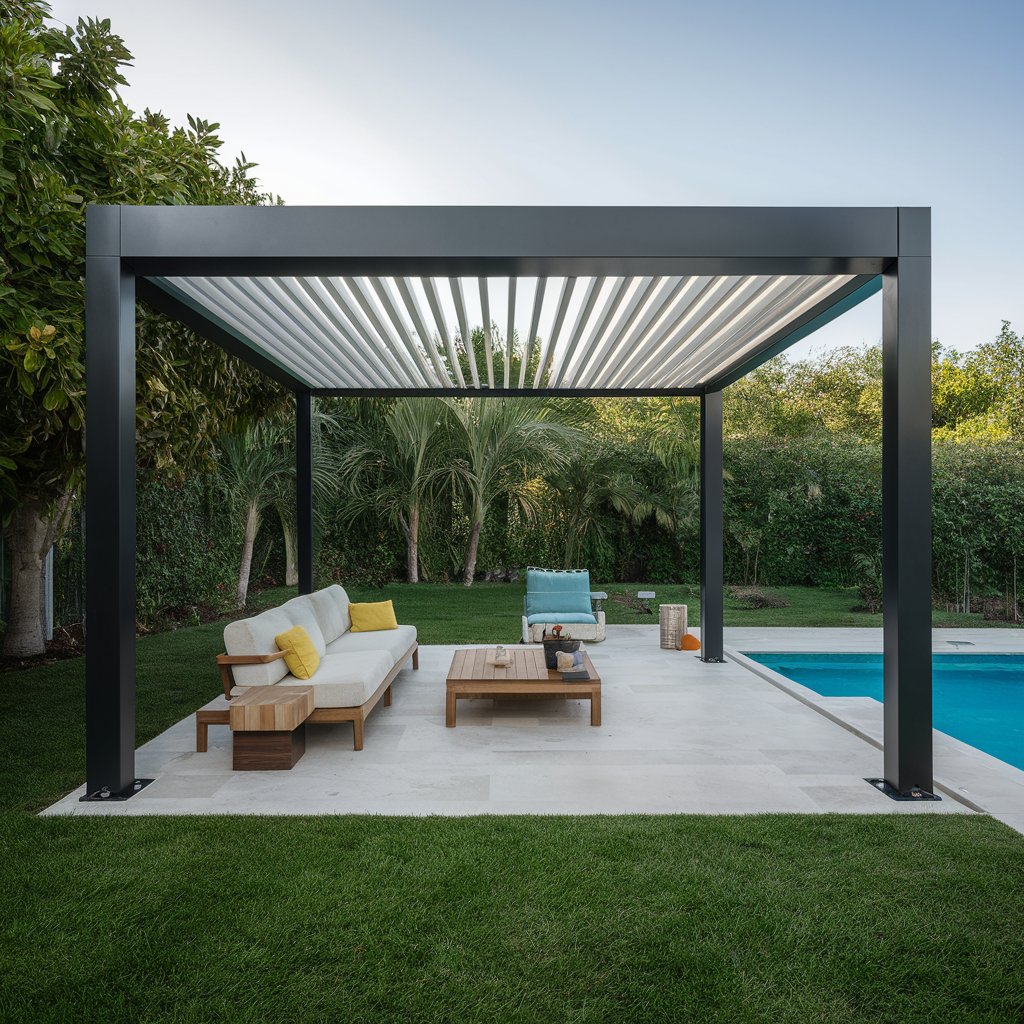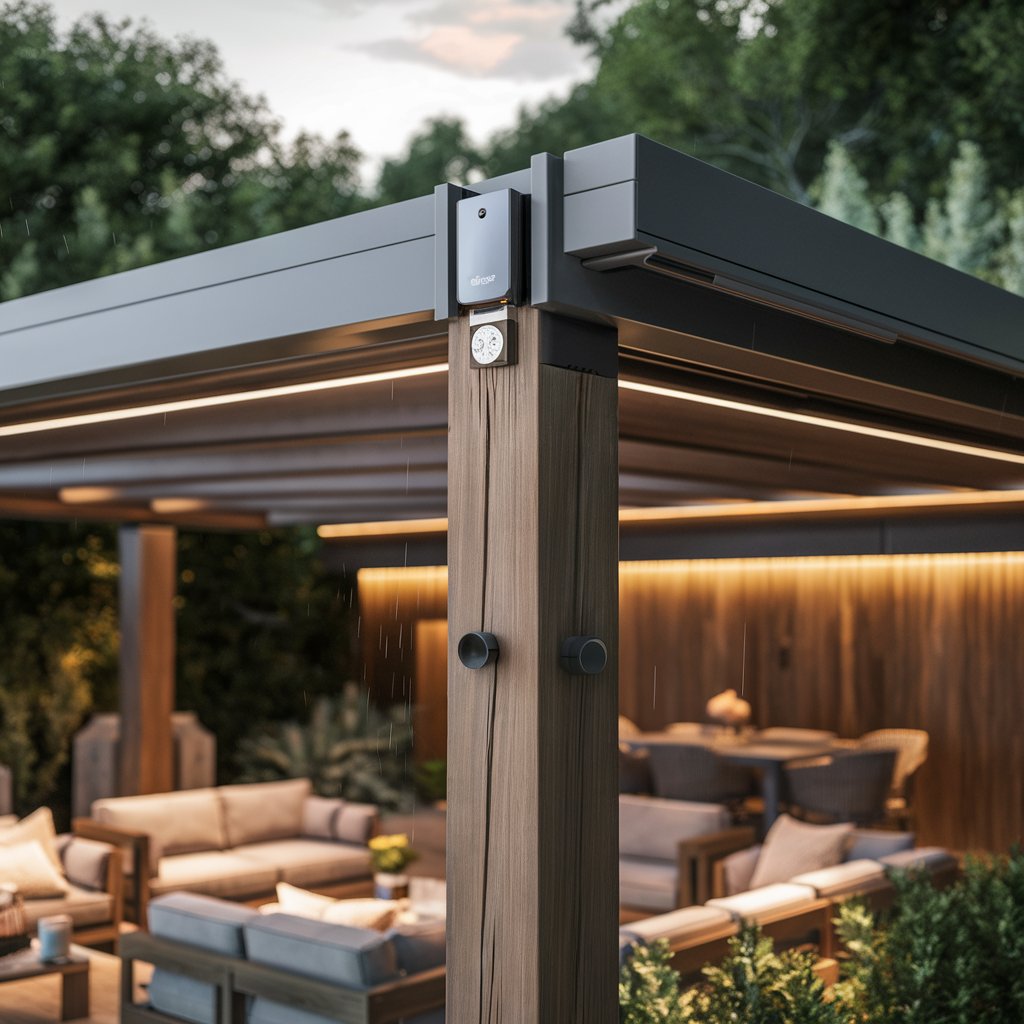Outdoor living spaces have become an integral part of modern home design, offering a seamless transition between the indoors and the natural environment. A pergola is a popular architectural feature that provides both aesthetic appeal and functional outdoor space. However, traditional pergolas are often limited by weather conditions, particularly rain, which can restrict their usability. Enter the rainproof pergola, a sophisticated solution designed to maintain the charm of outdoor living while offering protection from the elements. This article explores the intricacies of rainproof pergolas, focusing on their design, construction, materials, and operational mechanisms.
1. Evolution and Purpose of Rainproof Pergolas
1.1 Historical Context
Pergolas have been used since ancient times, with roots tracing back to classical gardens in Egypt, Greece, and Rome. These structures were initially designed to support climbing plants, creating shaded walkways, or as extensions of buildings, providing semi-covered spaces for relaxation and social activities. The traditional pergola consisted of vertical posts supporting cross-beams and an open lattice, allowing for sunlight and airflow while providing partial shade.
1.2 Modern Adaptations
In contemporary design, pergolas have evolved to suit a variety of architectural styles and functional needs. Modern pergolas can be free-standing or attached to buildings, constructed from materials like wood, metal, and vinyl. The advent of rainproof pergolas represents a significant innovation, addressing the limitations of traditional designs by incorporating weather-resistant features that extend their usability regardless of weather conditions.
2. Core Components of a Rainproof Pergola
2.1 Adjustable Louvers or Slats
The hallmark of a rainproof pergola is its adjustable louvers or slats. These elements can be tilted or completely closed to form a solid roof, offering protection from rain. The louvers are usually crafted from durable materials such as aluminum or treated wood, designed to withstand prolonged exposure to the elements without warping or deteriorating.
- Functionality: Louvers can be adjusted manually using a crank mechanism or automatically via an electric motor. Some systems are even equipped with remote control or smartphone integration, allowing for convenient operation.
- Design: When open, the louvers allow for natural light and ventilation, maintaining the airy feel of a traditional pergola. When closed, they overlap tightly, forming a waterproof barrier that channels rainwater into an integrated drainage system.

2.2 Integrated Gutter System
A rainproof pergola’s effectiveness hinges on its ability to manage water efficiently. An integrated gutter system is crucial for this purpose.
- Construction: Gutters are typically built into the pergola’s frame, seamlessly blending with its design. They are positioned to catch water from the louvers when they are closed.
- Drainage: The gutters direct water to downspouts, which then channel it away from the pergola’s base. This prevents water from pooling and ensures the area beneath the pergola remains dry.
2.3 Waterproof Materials
The choice of materials is critical in ensuring the longevity and functionality of a rainproof pergola.
- Aluminum: Often used for louvers and structural components due to its lightweight, corrosion-resistant properties.
- Stainless Steel: Commonly used for hardware and mechanisms, providing strength and resistance to rust.
- Treated Wood: For those who prefer a natural look, treated or composite wood can be used, offering resistance to moisture and decay.
2.4 Sealed Joints and Connections
To prevent leaks, the joints and connections of a rainproof pergola must be meticulously sealed.
- Gaskets and Sealants: High-quality rubber gaskets and waterproof sealants are used at critical points to ensure no water penetrates the structure.
- Precision Engineering: Advanced manufacturing techniques ensure that all components fit together perfectly, enhancing the pergola’s overall weather resistance.
2.5 Weather Sensors
For added convenience and protection, some rainproof pergolas are equipped with weather sensors.
- Rain Sensors: These sensors detect moisture and automatically close the louvers when rain is detected, ensuring the area remains dry even if no one is present to adjust the louvers manually.
- Wind Sensors: Some systems also include wind sensors that adjust the louvers to reduce wind load on the structure, preventing potential damage during strong gusts.
3. Design and Aesthetic Considerations of Rainproof Pergola
3.1 Architectural Styles
Rainproof pergolas can be tailored to complement various architectural styles, from modern minimalist designs to classic traditional aesthetics.
- Modern: Clean lines, sleek materials like aluminum, and minimalist design elements characterize modern rainproof pergolas.
- Traditional: Incorporating natural materials such as wood, detailed craftsmanship, and classic design motifs can make rainproof pergolas blend seamlessly with traditional homes.
- Hybrid: Combining elements from different styles allows for unique, personalized designs that cater to specific tastes and functional requirements.
3.2 Customization Options
Customization is a significant advantage of rainproof pergolas, offering homeowners the flexibility to create a space that suits their needs and preferences.
- Colors and Finishes: A wide range of colors and finishes is available, allowing for coordination with existing outdoor decor and architectural features.
- Additional Features: Options such as integrated lighting, ceiling fans, and heaters can be added to enhance comfort and usability.
- Size and Configuration: Pergolas can be designed to fit various spaces, from small patios to large outdoor entertainment areas.
4. Functional Benefits Rainproof Pergola
4.1 Weather Protection
The primary benefit of a rainproof pergola is its ability to provide shelter from rain, allowing for continuous use of outdoor spaces.
- Versatility: Regardless of weather conditions, a rainproof pergola ensures that outdoor activities can proceed uninterrupted.
- Comfort: By providing shade and protection, these pergolas enhance comfort, making outdoor spaces more enjoyable year-round.
4.2 Energy Efficiency
Rainproof pergolas can also contribute to energy efficiency by reducing the need for indoor climate control.
- Shade: In hot weather, closing the louvers can provide shade, reducing the need for air conditioning inside adjacent buildings.
- Ventilation: Adjustable louvers allow for controlled ventilation, promoting natural cooling and reducing reliance on mechanical systems.
4.3 Increased Property Value
Investing in a rainproof pergola can significantly increase property value by enhancing outdoor living spaces.
- Curb Appeal: A well-designed pergola adds aesthetic appeal, making the property more attractive to potential buyers.
- Functional Space: By creating versatile outdoor areas, a rainproof pergola effectively expands the usable square footage of a home.
5. Installation and Maintenance Rainproof Pergola

5.1 Professional Installation
Proper installation is crucial for the performance and longevity of a rainproof pergola.
- Expertise: Professional installers have the skills and experience to ensure the pergola is correctly assembled and integrated with existing structures.Precision: Accurate installation ensures that all components function as intended, particularly the gutter system and louver mechanisms.
5.2 Routine Maintenance
Maintaining a rainproof pergola is essential to preserve its functionality and appearance.
- Cleaning: Regular cleaning of louvers, gutters, and downspouts prevents blockages and ensures efficient water drainage.
- Inspection: Periodic inspections help identify and address any wear or damage, such as worn gaskets or loose connections.Lubrication: Moving parts, particularly in motorized systems, require lubrication to operate smoothly and prevent mechanical issues.
6. Technological Innovations
6.1 Automation and Smart Integration
Technological advancements have made rainproof pergolas more convenient and user-friendly.
- Automation: Motorized systems can be programmed to adjust louvers automatically based on weather conditions or user preferences.
- Smart Home Integration: Integration with smart home systems allows for remote control and monitoring via smartphones or voice-activated devices.
6.2 Sustainable Design
Sustainability is increasingly important in modern construction, and rainproof pergolas are no exception.
- Eco-Friendly Materials: Using recyclable materials like aluminum and sustainably sourced wood reduces the environmental impact.
- Energy Efficiency: Enhancing natural ventilation and shading reduces energy consumption, contributing to a greener home.
7. Case Studies and Real-World Examples
7.1 Residential Applications
Numerous homeowners have successfully integrated rainproof pergolas into their outdoor spaces, enhancing their lifestyle and property value.
- Backyard Retreat: Transforming a simple backyard into a luxurious retreat with a rainproof pergola, complete with integrated lighting and a heating system for year-round use.
- Patio Extension: Extending the living space of a home by adding a rainproof pergola to a patio, creating an ideal setting for outdoor dining and entertaining.
7.2 Commercial Applications
Rainproof pergolas are also valuable in commercial settings, providing functional outdoor spaces for businesses.
- Restaurants and Cafes: Expanding seating areas with rainproof pergolas allows for outdoor dining regardless of weather, increasing capacity and revenue.
- Hotels and Resorts: Enhancing guest experience by offering comfortable, weather-protected outdoor lounges and poolside cabanas.
8. Conclusion
Rainproof pergolas represent a significant advancement in outdoor living design, offering the perfect blend of aesthetics, functionality, and durability. By incorporating adjustable louvers, integrated gutter systems, waterproof materials, and smart technology, these structures provide a versatile solution that enhances the usability and enjoyment of outdoor spaces in any weather. Whether for residential or commercial applications, rainproof pergolas are an investment in comfort, convenience, and property value.
In conclusion, the rainproof pergola exemplifies modern innovation in architectural design, merging practicality with beauty. Its ability to adapt to changing weather conditions while providing a stylish and functional outdoor space makes it a valuable addition to any property. By understanding the components, benefits, and applications of rainproof pergolas, homeowners and businesses can make informed decisions to enhance their outdoor environments, ensuring comfort and enjoyment throughout the year.



Pingback: Waterproof Pergolas Add Value to Backyard - Oscar Shades
You have mentioned very interesting points! ps decent internet site.Blog money